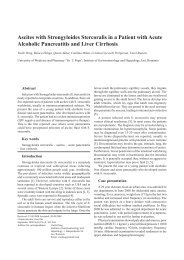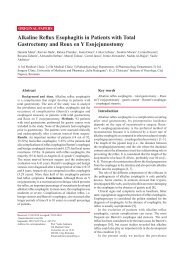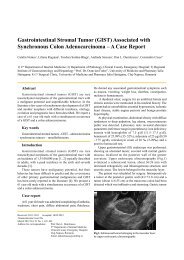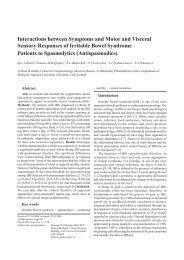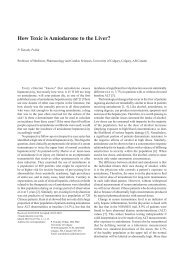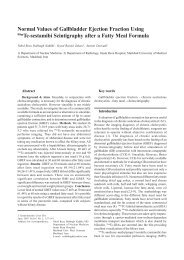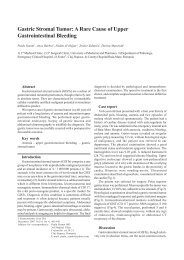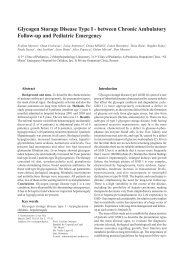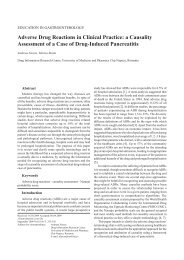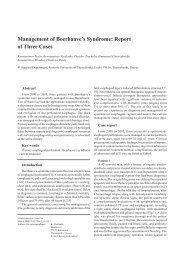The Association Between Helicobacter Pylori Chronic Gastritis ...
The Association Between Helicobacter Pylori Chronic Gastritis ...
The Association Between Helicobacter Pylori Chronic Gastritis ...
You also want an ePaper? Increase the reach of your titles
YUMPU automatically turns print PDFs into web optimized ePapers that Google loves.
CASE REPORTS<br />
<strong>The</strong> <strong>Association</strong> <strong>Between</strong> <strong>Helicobacter</strong> <strong>Pylori</strong> <strong>Chronic</strong><br />
<strong>Gastritis</strong>, Psychological Trauma and Somatization Disorder.<br />
A Case Report<br />
Bianca Andreica-Sandica 1,4 , Alina Panaete 1 , Raluca Pascanu 1 , Costica Sarban 2 , Vasile Andreica 3,4<br />
1) Pediatric Psychiatry Clinic; 2) Pediatric Clinic 2; 3) Regional Institute of Gastroenterology and Hepatology; 4) Iuliu<br />
Hatieganu University of Medicine and Pharmacy, Cluj-Napoca, Romania<br />
Abstract<br />
<strong>Helicobacter</strong> <strong>Pylori</strong> is considered to be the agent<br />
responsible for peptic ulcers and gastritis, and its eradication<br />
represents a main objective in the treatment of digestive<br />
diseases. We present the case report of a female patient<br />
diagnosed with chronic <strong>Helicobacter</strong> <strong>Pylori</strong> infection, where<br />
symptoms manifested after the patient was raped. In the<br />
context of psychological trauma, digestive manifestations<br />
such as ulcer and gastritis were identified, greatly exacerbated<br />
as compared with the endoscopic and histological aspect of<br />
the gastric mucosa. <strong>The</strong> patient simultaneously developed<br />
a complex psychiatric pathology. <strong>The</strong> association between<br />
<strong>Helicobacter</strong> <strong>Pylori</strong> chronic gastritis, somatization and<br />
trauma is discussed.<br />
Key words<br />
<strong>Helicobacter</strong> <strong>Pylori</strong> – chronic gastritis – trauma.<br />
Introduction<br />
<strong>The</strong> 20th century has presented a bio-psycho-social model<br />
of the disease, implying that genetic and early environmental<br />
factors may shape an individual’s predisposition to the<br />
disease, in which biological, psychological and social<br />
variables may determine the onset and subsequent course<br />
of a clinical disorder [1].<br />
Case report<br />
A female patient, aged 17 years and 5 months, was<br />
sent to our psychiatry unit in order to identify the presence<br />
of potential psychological factors which sustained and<br />
aggravated her gastric pathology, and to evaluate certain<br />
Received: 20.05.2011 Accepted: 05.06.2011<br />
J Gastrointestin Liver Dis<br />
September 2011 Vol. 20 No 3, 311-313<br />
Address for correspondence: Bianca Andreica –Sandica<br />
Pediatric Psychiatry Clinic<br />
Cluj-Napoca, Romania<br />
Email: sbandreica@yahoo.com<br />
memory disturbances. <strong>The</strong> reasons for admission to hospital<br />
were intense epigastric pain, heartburn, hematemesis,<br />
melena, headache, paresthesia of the hand and right lower<br />
extremity and cyclic amnesia. She was evaluated in a medical<br />
unit, which referred the patient to the psychiatry unit due<br />
to the fact that the intensity and the duration of digestive<br />
symptoms were much stronger as compared with the existing<br />
diagnosis of chronic gastritis.<br />
<strong>The</strong> patient had complained of gastric symptoms since<br />
2007, the year in which she was a victim of a traumatic<br />
experience (rape). Five months after the trauma she fainted<br />
and was examined in the emergency ward; she was discovered<br />
to be 5 months pregnant, a moment which marked the onset<br />
of dissociative psychosis. After giving birth to a baby girl,<br />
the mental symptoms intensified, and she was followed-up<br />
by an outpatient unit which prescribed antipsychotic and<br />
anxiolytic treatment, followed for one year.<br />
In 2007 she was diagnosed with a bleeding gastric<br />
ulcer (the patient presented two medical letters issued<br />
by the surgical clinic with two exploratory laparotomies,<br />
but no evidence of gastric resection). In 2008 she had an<br />
appendectomy. In 2010 she was again examined with a<br />
bleeding gastric ulcer, having hematemesis, secondary<br />
anemia, hypocalcemic tetany (documented by a medical<br />
report). Previous medical reports presented by the patient<br />
showed that she had underwent periodic treatments of 7-10<br />
days duration for chronic gastritis with <strong>Helicobacter</strong> <strong>Pylori</strong><br />
(HP) infection. <strong>The</strong> patient insisted on having three upper<br />
digestive endoscopies in the course of the current year (2011)<br />
in order to find the cause of hematemesis. All the documents<br />
showed that the esophagus, the duodenum and stomach had<br />
a normal endoscopic aspect.<br />
<strong>The</strong> family history offered no relevant data. <strong>The</strong> patient<br />
did not consume drugs, alcohol and did not smoke. A more<br />
detailed questionnaire revealed that the patient made the<br />
effort and succeeded in manually extracting two molars,<br />
swallowing the blood resulting from the dental wounds.<br />
From 2007 onwards, the patient also intermittently<br />
complained of chest and back pains, which were investigated<br />
without finding pathological changes.<br />
Examination of her oral cavity revealed post dental self-
312 Andreica-Sandica et al<br />
extraction wounds. She presented moderate abdominal pain<br />
at palpation, and a visible xypho-umbilical scar, secondary to<br />
the exploratory laparotomies, and a post-appendectomy scar<br />
in the right iliac fossa. <strong>The</strong> stool had the aspect of melena.<br />
<strong>The</strong> psychiatric and psychological examination revealed:<br />
deficient amnesia on three episodes (when she goes to the<br />
place where the rape happened, she “awakens”, doesn’t know<br />
who she is, checks her ID card for her name and address),<br />
irritability, emotional weakness, diminished self-defense<br />
instinct; she blocked herself when attempting to discuss<br />
the trauma suffered, spoke of her daughter as if she were<br />
her sister, has a craving for attention, need to impress her<br />
entourage, normal intellectual ability, developing personality<br />
with unstable psycho-affective elements, state of depression<br />
and diminished tolerance to stress, sleep complaints,<br />
impulsive and aggressive tendency.<br />
<strong>The</strong> neurological examination showed unsystematic<br />
hypoesthesia in the right upper limb.<br />
Laboratory investigations were normal, except mild<br />
anemia: erythrocyte count 4.38 mil/μl (VN=4.3-5.4),<br />
hemoglobin 10.8 g/dl (VN=12.1-17.2); hematocrit 34.4%<br />
(36.8-50.2), mean erythrocyte volume 78.4 fl (VN=83-93),<br />
mean erythrocyte hemoglobin 24.7pg (VN=26.8-31.8).<br />
At the upper digestive endoscopy repeated on admission,<br />
oesophagus, gastric body, duodenum evidenced a normal<br />
endoscopic aspect. <strong>The</strong> histopathological examination<br />
showed a superficial chronic gastritis, with a moderate<br />
inflammatory infiltration with round-nuclear and rare PMN<br />
cells in the chorion, and presence of HP.<br />
<strong>The</strong> oto-rhino-pharyngeal examination evidenced a<br />
normal aspect. <strong>The</strong> EEG in the awake state presented<br />
hypovolted trajectory, insufficiently developed, slower<br />
in right centro-parietal derivations (lesional?). A cerebral<br />
angio MRI scan was then recommended. This revealed a<br />
millimetric lesion most probably of an inflammatory nature<br />
located at the left external capsule level; without any further<br />
focal cerebral lesions; without super or infratentorial tumor<br />
formations; non-dilated symmetrical ventricular system. A<br />
repeat scan at 6 months was recommended.<br />
We established the diagnosis of superficial chronic<br />
gastritis with HP infection, melena following ingestion<br />
of blood resulting from the dental auto extraction wound,<br />
mild anemia, somatization disease and post-traumatic stress<br />
syndrome.<br />
Discussion<br />
Rape represented the ”trigger” factor which coincided<br />
with the onset of a series of painful recurrent digestive<br />
syndromes, the patient being diagnosed with chronic gastritis,<br />
a renal cyst, appendicitis. For certain digestive complaints,<br />
even surgical interventions were performed. <strong>The</strong> patient<br />
simultaneously developed a complex psychiatric picture:<br />
acute reaction to stress, post-traumatic stress disorder,<br />
dissociative psychosis, post psychotic depression.<br />
As a reaction to trauma the patient developed a separate<br />
personality from which she could not access information<br />
related to the rape, and another one (to the forefront during<br />
anamnestic incursions or during hypnosis) in which she relived<br />
the traumatic event. <strong>The</strong> feelings blocked by the impossibility<br />
of verbalization found an outlet through the body, in the form<br />
of pain with different locations (predominantly digestive<br />
tract), paresthesia alternating with painful anaesthesia (she<br />
manually extracted two of her molars, while hematemesis<br />
and melena proved to be the result of inducing haemorhage<br />
in the dental insertion slots).<br />
<strong>The</strong> complaints reported by the patient exceeded the<br />
usual complaints of gastritis. <strong>The</strong> patient presented a history<br />
of multiple somatic complains, occurring over two years<br />
(epigastric pain, pain in the lower abdomen, precardial and<br />
back pain, hematemesis, melena), which could not be fully<br />
justifiable by a commonly accepted medical condition [2].<br />
Numerous studies have tried to verify the hypothesis<br />
that trauma can trigger gastric pathology; however,<br />
data is conflicting [3-5]. <strong>Gastritis</strong> and peptic ulcer were<br />
initially described as psychosomatic pathology, having as<br />
vulnerability factors an ambitious or dependent personality.<br />
But because no strong association was discovered between<br />
the psychogenetic factors and the digestive symptoms or the<br />
endoscopic aspect of the stomach, research was gradually<br />
oriented towards the discovery of other etiologies [6, 7].<br />
Over the past decades, in the pathogenesis of ulcer<br />
and gastritis the role of HP infection and of non steroid<br />
anti-inflammatory drugs (NSAIDs) has been documented.<br />
Epidemiological studies have shown that despite the decrease<br />
in the HP prevalence in Western countries and the increase<br />
in the availability of anti-HP drug therapy, the prevalence of<br />
peptic diseases is relatively high [8]. A proportion of those<br />
infected with HP do not develop gastric pathology [6]. In<br />
5-20% of the patients with gastric disease no etiologic factors<br />
are identified [9, 10].<br />
Some studies evaluated the association between early<br />
trauma, anxiety and gastric ulcer/gastritis [11]. <strong>The</strong>re are<br />
several explanations for this association. Starting from the<br />
onset at an early age of generalized anxiety, the idea was<br />
postulated that chronic anxiety could in time determine<br />
dyspeptic symptoms, as well as peptic diseases [11].<br />
<strong>The</strong> hypothesis of a common genetic predisposition for<br />
anxiety and ulcer was issued [12]. Proof also exists that<br />
the recurrence of gastritis/ulcer can be associated with the<br />
presence of stressful life events [13]. An association between<br />
acute stress (earthquake, for example) and heightening of<br />
induced gastric lesions with HP was also identified [14].<br />
Based on the data presented by the patient, we do not<br />
consider that her clinical picture was the expression of<br />
chronic HP positive gastritis. <strong>The</strong> exacerbation of abdominal<br />
pains took place in the psychological context of the patient.<br />
Self mutilation (tooth extraction) expresses the patient’s<br />
intention (through bleeding) to make the digestive pains<br />
more plausible. <strong>The</strong> confirmation that she suffers from a<br />
severe digestive disease would enable her to substitute the<br />
tribulations generated by the gastric pain.<br />
A prospective study carried out on 2,416 patients not<br />
diagnosed with an ulcer showed that the use of minor
H. pylori chronic gastritis and somatization disorder 313<br />
tranquilizers (benzodiazepine) was statistically equally<br />
associated with the onset of a gastric ulcer as HP [1]. Our patient<br />
also followed anxiolytic treatment for almost one year.<br />
<strong>The</strong> Alameda study, conducted by Levenstein, has<br />
demonstrated the fact that depression and anomia are<br />
associated with gastritis and ulcers [15].<br />
Another study, carried out on 4,511 adults from the USA<br />
showed that persons who declared themselves to be subjected<br />
to stress were twice as likely to be exposed to ulcer/gastritis<br />
in the following 13 years, as compared with those who did<br />
not describe themselves as being stressed [1]. Successful<br />
HP treatment in patients with recurrent ulcers lead to the<br />
normalization of anxiety levels and neuroticism [16, 17].<br />
Conclusion<br />
From the presentation of this case, the following<br />
conclusion was drawn: melena and hematemesis do not<br />
always express a disease of the upper digestive tract. We<br />
should keep this in mind when treating patients who have<br />
undergone psychological trauma.<br />
Conflicts of interest<br />
None to declare.<br />
References<br />
1. Francis Creed. Gastrointestinal disease. In: Psychosomatic Medicine.<br />
Blumenfield M, Strain J. (eds). Lippincott Williams and Wilkins,<br />
Philadelphia 2009, 145-157.<br />
2. Tulburarea de somatizare. In: Manual de diagnostic si statistica a<br />
tulburarilor mentale. Ed IV revizuita. Asoc Psih Liberi din Romania.<br />
Bucharest 2003, 486-490.<br />
3. Peters MN , Richardson CT. Stressful life events, acid hypersecretion,<br />
and ulcer disease. Gastroenterology 1983; 1: 114–119.<br />
4. Freston JW. Review article: role of proton pump inhibitors in non-<br />
H. pylori-related ulcers. Aliment Pharmacol <strong>The</strong>r 2001;15 Suppl 2:<br />
2-5.<br />
5. Weisman AD. A study of the psychodynamics of duodenal ulcer<br />
exacerbations; with special reference to treatment and the problem<br />
of specificity. Psychosom Med 1956;18: 2–42.<br />
6. Marshall BJ. <strong>Helicobacter</strong> pylori in peptic ulcer: have Koch’s<br />
postulates been fulfilled? Ann Med 1995;27: 565–568.<br />
7. Piper DW, Tennant C. Stress and personality in patients with chronic<br />
peptic ulcer. J Clin Gastroenterol 1993; 16:211–214.<br />
8. Sugiyama T, Nishikawa K, Komatsu Y, et al. Attributable risk of H.<br />
pylori in peptic ulcer disease: does declining prevalence of infection<br />
in general population explain increasing frequency of non-H. pylori<br />
ulcers? Dig Dis Sci 2001; 46: 307–310.<br />
9. McColl KE, el-Nujumi AM, Chittajallu RS, et al. A study of the<br />
pathogenesis of <strong>Helicobacter</strong> pylori negative chronic duodenal<br />
ulceration. Gut 1993; 34:762–768.<br />
10. Konturek SJ, Bielanski W, Plonka M, et al. <strong>Helicobacter</strong> pylori,<br />
non-steroidal anti-inflammatory drugs and smoking in risk pattern<br />
of gastroduodenal ulcers. Scand J Gastroenterol 2003;9: 923–930.<br />
11. Kessler RC, Keller MB, Wittchen HU. <strong>The</strong> epidemiology of generalized<br />
anxiety disorder. Psychiatr Clin North Am 2001;24:19-39.<br />
12. Weiner H. From simplicity to complexity (1950-1990): the case of<br />
peptic ulceration--II. Animal studies. Psychosom Med 1991; 53:<br />
491-516.<br />
13. Ellard K, Beaurepaire J, Jones M, Piper D, Tennant C. Acute and<br />
chronic stress in duodenal ulcer disease. Gastroenterology 1990, 99:<br />
1628-1632.<br />
14. Matsushima Y, Aoyama N, Fukuda Het al. Gastric ulcer formation<br />
after the Hanshin-Awaji earthquake: a case-study of <strong>Helicobacter</strong><br />
pylori infection and stress-induced gastric ulcers. <strong>Helicobacter</strong> 1999;<br />
4: 94-99.<br />
15. Levenstein S. <strong>The</strong> very model of a modern etiology: a biopsychosocial<br />
view of peptic ulcer. Psychosom Med 2000; 62: 176-185.<br />
16. Drossman DA. Presidential address: Gastrointestinal illness and the<br />
biopsychosocial model. Psychosom Med 1998; 60: 258-267.<br />
17. Jones MP. <strong>The</strong> role of psychosocial factors in peptic ulcer disease:<br />
bBeyond <strong>Helicobacter</strong> pylori and NSAIDs. J Psychosom Res 2006;<br />
60: 407-412.




